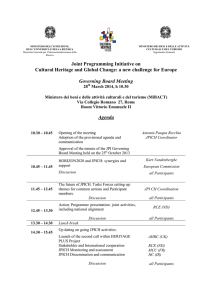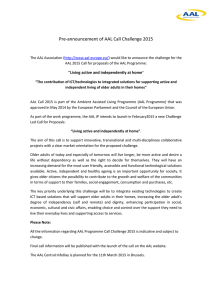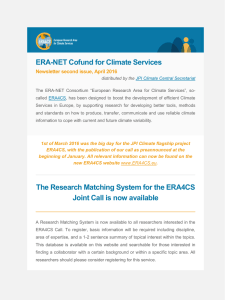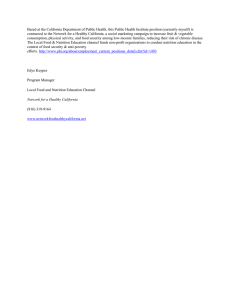REPORT AAL- JPI HDHL Joint Workshop: ICT and the future of
advertisement
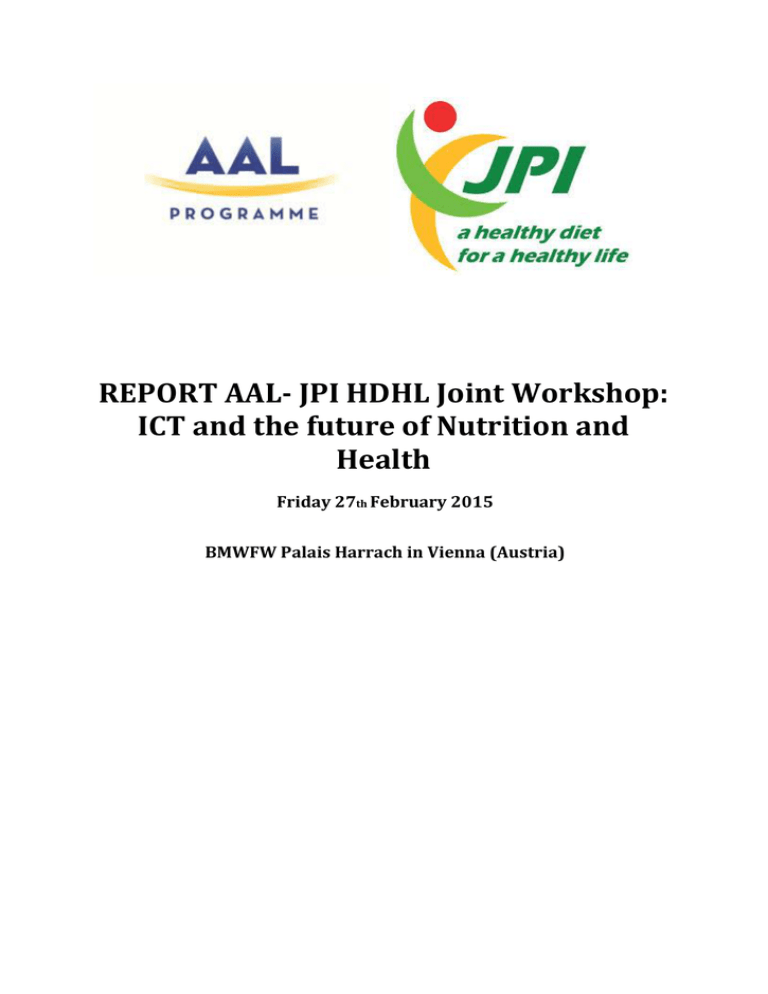
REPORT AAL- JPI HDHL Joint Workshop: ICT and the future of Nutrition and Health Friday 27th February 2015 BMWFW Palais Harrach in Vienna (Austria) A. INTRODUCTION of the workshop On Friday the 27th of February the workshop ‘ICT and the future of Nutrition and Health’ took place at the BMWFW Palais Harrach in Vienna. This workshop was a joint initiative of the Active and Assisted Living (AAL) Programme and the Joint Programming Initiative A Healthy Diet for A Healthy Life (JPI HDHL). The participants were welcomed by Dr. Hemma Bauwer, Head Life science Unit of BMWFW. The programme is included in the Annexe. The aim of the workshop was to share knowledge on the area where JPI HDHL and AAL come together, to identify gaps and recommend future joints actions and opportunities for collaboration. Scientist and experts (also industry, especially SME) in the field of AAL and JPI HDHL explored together how ICT can co-create the future of Nutrition and Health e.g. tailored information on dietary intake and health parameter & personal advice through ICT tools. Rafael de Andres Medina (AAL President) provided the audience with an introduction about AAL, including its achievements and the rational for a collaboration between AAL and JPI HDH.L (presentation available). The AAL Programme is a European funding initiative, driven by 19 partner states, aiming at enhancing the quality of life of older people and strengthen the industrial base in Europe through the use of Information and Communication Technologies (ICT). Therefore, it fosters social innovation via technologies and services to enable active ageing among the population. The AAL Programme focuses on the improvement of the autonomy, participation in social like, skills and employability of older adults and effectiveness of health and social care provision. It implements challenge driven calls for proposals and support actions, which support industry, and in particular SMEs, to bring innovative digital products and services for ageing well to the European market. The first AAL Joint Programme (2008 – 2013) funded 120 projects and over 350 SMEs were involved as a partners within these projects. The current AAL Programme (2014-2020) has a planned budget of 700 mi Euros, which includes the European Commission, the EU Member States and the participants’ contribution. The presentation was followed by Andreas Aeschlimann (MB member JPI HDHL) who elaborated on the concept of Joint Programming, the vision of JPI HDHL and its current achievements and future plans. The concept of Joint Programming started a couple of years ago to address major societal challenges which are so great that national research programmes cannot tackled them effectively on their own. The majority of available 2 research funding in Europe is through national research programmes and these are run in an isolated way, leading to unwanted fragmentation or ineffectiveness. In the concept of Joint Programming countries – EU Member States, associated countries and third countries – collaborate to align their national research programmes based on a shared vision and Strategic Research Agenda. Furthermore Joint Actions – international research projects – are funded on those areas where international collaboration between researchers should have an added value on top of or instead of national research project. In the Foresight Activities of JPI HDHL the importance of ICT and communication for the different research pillars of JPI HDHL was marked as an issue to further explore. JPI HDHL is currently in the process of updating its Strategic Research Agenda and drafting its Implementation Plan 2016-2018. The outcomes of the workshop can provide input for these strategic documents (presentation available). JPI HDHL is a European, 25 member state driven initiative (including associated states and third countries) that aims to better understand the factors that determine food choices and physical activity behaviour patterns, and thus human health, to subsequently translate this knowledge into programmes, products, tools and services that promote healthy food choices. Karina Marcus, AAL CMU Director presented the 9 AAL projects currently funded that have a link with nutrition and dietary needs. These projects are: Emotionaal; Remote; Osteolink; Tranutri; FOOD; Chefmyself; Diet4Elders; EDLAH and Helicopter. These 9 projects together have a budget of 24.2 million euro of which 13.2 million euro is funding received from AAL through the EC and MS. In total 70 persons are directly involved with these projects; of which 27 SMEs and 17 End-user organisations (presentation available). Prof. dr. Hannelore Daniel, the chair of the Scientific Advisory Board of JPI HDHL concluded the morning session with a presentation on the scientists´ perspective from the JPI HDHL research community for a collaboration between AAL and JPI HDHL (presentation available). What science and technology related to AAL can bring for the research pillars of JPI HDHL: Pillar 1: DETERMINANTS OF DIET AND PHYSICAL ACTIVITY: ensuring the healthy choice is the easy choice for all consumers. The challenge is to understand the most effective ways for improving public health through interventions targeting motivation, ability and opportunity to adopt and maintain healthy dietary and physical activity behaviours. 3 Devices/instruments that can quantify life style parameters – e.g. map of fast food restaurants in the direct environment of consumers; physical activity tools and food intake assessment. The last one is a big challenge – as consumers don’t like questionnaire and also tend to be not honest when completing them. Pillar 2: DIET AND FOOD PRODUCTION: developing healthy, high-quality, safe and sustainable foods. The challenge is to stimulate the European consumers to select foods that fit into a healthy diet and to stimulate the food industry to produce healthier, high-quality foods in a safe, sustainable and affordable way. New information systems for proper food choices – to get closer to personalised advice e.g. advice systems that provide you with feedback on bio parameters (e.g. glucose levels). Pillar 3: DIET-RELATED CHRONIC DISEASES: preventing diet-related, chronic diseases and increasing the quality of life. The challenge is to prevent or delay the onset of diet-related chronic diseases by gaining a better understanding of the impact of nutrition and lifestyle across Europe on human health and diseases. ICT based solutions for management of chronic diseases – for example a teddy bear that can talk and move and will talk about food to help the elderly to enjoy food again. Food4me The Food4me project is elaborated on in the presentation of Hannelore Daniel as the best practice when talking about ICT/technology developments and Nutrition & Health. The Food4me project aims to determine the application of personalised nutrition, through the development of suitable business models, research on technological advances, and validation of delivery methods for personalised nutrition advice. A second aim of the project it to compile current scientific knowledge and consumer understanding of personalised nutrition—including best practice communication strategies and ethical boundaries—to be shared with the EU institutions, the food industry, and other stakeholders. The Food4Me consortium – led by prof. Mike Gibney of University College Dublin – consists of 25 partners from 12 European countries. It brings together a multi-disciplinary team in the fields of biological sciences, consumer studies, marketing, business development, IT and technology, ethical and legal industry, and communication. 4 B. SUBSESSION Sub session 1: E-health and personalized nutrition Chair: Gerda Geyer, AAL-NCP Austria Rapporteur: Wilke van Ansem, CSA JPI HDHL Participants: Serge Autexier, Laura Boffi, Juan Luis Carus Candas, Ana Correia de Barorros, Hannelore Daniel, Daniela Fichtenbauer, Eilein Gibney, Ben van Ommen, Victor Sanchez , Christian Schoen and Jan Urbanowicz. Introduction The aim of this subgroup was to explore the opportunities of personalized nutrition using ICT-tools. The participants explored together how developed ICT–tools can be used in research targeting personalised medicine. In addition, the role of the JPI HDHL and the AAL Programme to contribute to this topic would be discussed and potential knowledge gaps will be indentified. The session started with elevator pitches in which the participants shortly introduced themselves and explain the topic for a future collaboration of the AAL Programme and the JPI HDHL. After the elevator pitches participants received yellow and green post-its. They were asked to indicate: A. The major issues in e-health and personalised nutrition on the green post-its B. What is needed in order to address the major issues in e-health and personalized nutrition on the yellow post-it’s. Major issues in e-health and personalised nutrition Participants grouped the green post-its and discussed the following issues: Food intake and feeding habits Environment (country, municipality) Abilities of elderly (e.g. skills, socio-economic position) Monitoring of food intake Participants agreed that at a first level we need to know and understand better what people eat and why (motivation, empowerment), to enable people for effective behavioural changes. Participants also discussed the need to distinguish at age, as at a certain age the environment that elderly people encounter will change. This change in environment has a big influence on the quality of life and the health status of the elderly. What is needed in order to address the major issues in e-health and personalized nutrition 5 First the participants discussed what kind of data is needed in order to address the identified issues. In summary the participants agreed that it is necessary that the data should be coming from users and stakeholders. Data that should be collected included nutritional data, data regarding the motivation and data regarding users’ behaviour is necessary. Subsequently the participant discussed the future collaboration of the JPI HDHL and AAL. In summary participants suggested: a joint call on nutrition, ICT and the elderly population (theme: healthy ageing). A matchmaking event o It was indicated that it is hard to find partners for project (especially between ITC designers/ developers and health researchers). A matchmaking event organised by JPI HDHL and ALL can facilitate/ support the establishment of consortia with both (scientific) expertise in ICT designers; ICT developers and nutrition/ health researchers. Sub session 2: Market availability Chair: Karin Marcus Rapporteur: Jolien Wenink Participants: Janet Cade, Pablo Coca, Tamas Grosz, Dimitrios Kilias, Tony Lam, Lucas Malicki, Walter Scheitz, Hans Verhagen, Ana Villacampa and Stephen Webb A. Elevator pitches The focus of this subgroup was to investigate who are the buyers of the solutions, who will make revenues out of them and if and how the market can go beyond the lifestyle consumer. In addition, the role of the JPI HDHL and the AAL Programme to contribute to this topic would be discussed and potential knowledge gaps would be indentified. The workshop started with an elevator pitch from each of the participants of the workshop. In the elevator pitches the following themes were touched: Data: o How can we use collected data more effective? How can you get more information out of big data – which is collected through databases and surveys about food intake and food composition?? How can you increase the efficacy? o Integrating data from difference sources can improve the quality assurance. 6 o Standardisation on how to provide the data will increase the effectiveness of its use. o Companies should design apps that make the scientific data available for SMEs. Entrepreneurship: o It should not be forgotten to not only to look to the user and the user needs, but also how to make a business out of a service or application. o Researchers should find the entrepreneur within themselves or connect with those persons who can look to a research proposal or project from an entrepreneur perspective. o In the area of food and nutrition it is difficult to get consumers interested in a tool for a long time – most of the time consumers stay only on a diet for 3 months. o It is not possible to make money out of selling an application – though it might be in selling an application together with a service or hardware. Knowledge transfer: o At the end of a project it is important that the results will be brought a step further. In practice this could be a trade of with the scientist interest which is more focussed on scientific publications and presentations. o Tools could help consumers and professionals to get insights in the amount of calories that we consume. B. Discussion After the elevator pitch, the participants had an in-depth discussion and the development of markets. The following topics have been addressed: What would be specific in the solutions for diet and nutrition in the silver economy, i.e. for the older population, in comparison to the younger one? What are the issues that are preventing the development of markets or restricting uptake of current existing solutions? To investigate who are the buyers of the current and future solutions To investigate who will make revenues out of them To identify how the market can go beyond the lifestyle consumer The Elderly The definition of ‘the elderly’ is shortly discussed. In general there is a big debate on ‘what is an old person’, and the answer can depend on variables like the region that you are in and the type of products that you are focussed on, but even then there is a large variety within age groups. It should not be taken for granted that European – and 7 especially the older age groups – are e-connected. There for the AAL project subsidises a whole pallet on devices from TV and phones to tablets. Applications The experiences with the market-value of smart phone applications are discussed. With an application you have to stay active on the innovation of the application and the marketing (e.g. bloggers) for the application. When you stop these activities, the download rates of the applications will decrease. In general people use a maximum six apps for a long term, the others have only a temporarily use. It is much easier to have a business model when your target groups are the professionals – the professional can use an application in their contacts with the consumer. For instance general practisers, dieticians and nurses, but also the secondary care could be a targeting sector. Gamification is needed to get applications integrated in the everyday actions of the users – like a social software. Another problem is that is you have to provide user support for technical problems – it should be taken into account how much money is needed to deal with this issue. Buyers When talking about market availability in the area of Nutrition and Health it seems that the buyers are the same as in other areas of Public Health. Health Organisations, Public Health Institutions, the (local) government, sport and fitness clubs are mentioned, but also for example the Industry and Food Manufactures. Revenues There are more or less two types of revenues indicated by the participants: 1) For the services a. Who delivers the service: hospital; doctors; licensing the product b. Sponsorship; gyms/personal trainers 2) One who is developing the software a. Start-up/ SMEs b. Cost saving could be a barrier – you have to convince an hospital that it will save money i. What is linked to prevention – getting people out of prevention/or clinical applications. c. Is this linked to diet and nutrition or not necessarily. It is lifestyle – you cannot only improve you health style by eating i. It is more prevention. 8 Conclusion workshop 2 on Market Availability The participants have been asked to select together three priority issues that a future collaboration between AAL Programme and JPI HDHL should address. The following topics have been forwarded: 1. Can we use date more effective? a. Get more information out of big data? i. Data that is collected can be used at the individual and societal level; how to make the best use of the “big data” ii. Internet of food – how to connect and use all the information that can be conveyed via the connected objects and food b. Standardization of data c. Help the scientist with the business model i. It is important to think about new business models and how to get revenues 2. Research on effects of existing apps in this area and what are the benefits 3. Organisation of workshops for deeper collaboration between the two initiatives Subgroup 3: Social networking as tool for awareness and to assist healthy life style choices Chair: Andreas Aeschlimann, MB member JPI HDHL Rapporteur: Alain Franco, AAL Advisory Board member Participants: Andreas Aeschlimann, Alain Francor, Nanna Lien, Claudia Hildebrand, Claudia Pischke, Jeanine Budelmann, Paolo Ciampolini, Rafael de Andres Medina and Walter Wohlkinger. The participants of this workshop focused on discussing the strategies to implement personalized nutrition communication through interactive tools. In addition they discuss how ICT strategies can be used to reach target groups. In addition, the role of the JPI HDHL and the AAL Programme to contribute to this topic would be discussed and potential knowledge gaps would be indentified. The workshop started with an elevator pitch from each of the participants of the workshop. After the elevator pitch, the participants had an in-depth discussion regarding strategies to implement personalized nutrition communication trough interactive tools. In the first phase, the following comments were mentioned: 9 Setting clear aims; quality, quantity and distinguish target groups In spite of the complexity of the determinants of nutritional issues, there is a need to identify clearly the aims for a nutritional policy in Europe, in terms of quality and quantity, and according very different subgroups of population having very different needs. Technology may help if this issue is clear. Knowing the stakeholder It is important to take in account the social norms, activity, older people needs and wishes; there are already some physical activities apps. Interviews with stakeholders would be an important step to accomplish a useful tool. Understand ICT & identify the gaps and determinants It is important to understand how to use ICT and there is a need for proper and adapted interfaces. In addition it is important to find the right determinants of activity and identify the gaps. It should be a theme of multidisciplinary networks that could identify tools and help policies for interventions. It was also raised the question about what is a healthy condition – if it is linked only to medical aspects. Access to independent information There is a need for clear independent information in nutrition and also need of personal support and time. There is no broad promotion for the public independent information, compared with a large information base provided by the private stakeholders of food and nutrition. Pilot studies are very difficult and it is necessary to have a tool for the comparison between different cohorts and studies, which is difficult to do. The support to motivation is also very important. The access for services, data and content in this domain should be easy, with simple messages. Privacy could be a concern depending on the type of information provided. Industrial components Food products include industrial components. Smart kitchen services could help to know about usage and diet, and then some feedback for the user could be provided. By 2030 all Europeans should know what the best is in terms of nutrition. A longer perspective is need for to support the research and innovation actions. Industry accepts rules (quality), but health aspects bring problems. Who is validating food innovation in social networks? 10 Conclusion workshop 3 on Social networking as tool for awareness and to assist healthy life style choices The participants have been asked to select together three priority issues that a future collaboration between AAL programme and JPI HDHL should address. The following topics have been forwarded: It is difficult task to identify gaps in this specific area (social networks for diet and nutrition). There is much information available, with many different technologies targeting potentially many different publics via many networks. This can be linked also to different policy aims. It was then questioned about the current availability of information and applications in this domain and if older people are indeed using social networks. At some point even the concept of social network was debated. There should be a clear focus in the people and family members must be involved. One good opportunity for both initiatives was proposed as to build a European Social Network promoting healthy life styles choice. The example of a Swiss Facebook special page on nutrition. www.Foodold.ch was given. One should be careful with the following important points concerning the information: trust, confidence, clarity and adaptation to the person. Also it is necessary to avoid ageism and discrimination or stigmatization by age. 11 C. PLENARY WRAP- UP SESSION & Closing Remarks Each rapporteur informed the participants about the points discussed in the parallel sessions. In sub-group 1 the main points were about: Identifying what, and why people eat Food habits & intake Environment/ society/ enabling people Abilities of elderly Monitoring food intake and measuring Organizing a joint call AAL - HDHL In sub-group 2 the conclusions were about: Data that is collected can be used at the individual and societal level; how to make the best use of the “big data” It is important to think about new business models and how to get revenues Internet of food – how to connect and use all the information that can be conveyed via the connected objects and food Research on effects of existing apps in this area and what are the benefits Organisation of workshops for deeper collaboration between the two initiatives In sub-group 3 the following was reported: What is healthy? Independent information for consumers, with pilot testers. Public funding promotion compared with the private promotion. Collaboration between diet, social networks and technology Frameworks on nutrition and social networks It is important to provide feedback from the data to personal use with personalised messages. How can people use the resources? Trust and quality of the information are the key issues. A short discussion with the audience followed on these presentations. The audience agreed that there were important similarities in the conclusions from the three subgroups and that the joint activity should be continued, with a need to define some priorities areas and actions. The attendees were then asked to prioritize the points identified by the sub-groups, which gave the following three high scored items: 1. Launching a joint call AAL-HDHL (38 votes) 2. How to make best use of the ‘big data’ (22 votes) 12 a. Internet of food b. How to derive personal messages out of data 3. Stimulate network between ICT and Nutrition/Health (10) Closing remarks Rafael de Andrés Medina, president of the AAL Executive Board, closed the workshop indicating that the results of this workshop would be further discussed by the AAL Programme and the JPI HDHL to determine possible follow-up actions. Rafael de Andrés Medina expressed its gratitude for the hospitality of Austria to host the workshop and to the Steering Committee of JPI HDHL to be supportive to organize this explorative workshop together with AAL to look into possible directions for collaborations. It was a successful workshop, which showed the value of bringing different expertise together to discuss shared challenges from different angles. Rafael de Andrés Medina thanked the participants for their contribution and wished everybody a safe journey home. 13 Annex - Programme AAL- JPI HDHL Joint Workshop – Vienna, Friday 27th February 2015 Programme 09.00 – 10.00 Registration and Morning Coffee 10.30 – 10.40 Welcome Hemma Bauwer, BMWFW 10.40 - 10.50 AAL – ICT and smart technologies for coping with nutrition and diet- Rationale for a collaboration between AAL –JPI HDHL Rafael de Andrés Medina, AAL Executive Board President 10.50 – 11.00 JPI HDHL– Tackling the nutrition and diet challenge - Rationale for a collaboration between AAL –JPI HDHL Andreas Aeschlimann, Member of the JP HDHL Management Board 11.00 – 11.15 Overview of AAL projects / functionalities for people regarding nutrition and diet needs Karina Marcus, AAL CMU Director 11.15 – 11.30 JPI HDHL SRA – The scientists´ perspective from the JPI HDHL research community for a collaboration between AAL-JPI HDHL Hannelore Daniel, chair of the SAB of JPI HDHL 11.30 – 13.00 Parallel sub-group breakouts (with refreshments) 13.00 – 13.45 Networking Lunch 13.45 – 15.00 Parallel sub-groups continued Same sub-groups as morning session. Afternoon session includes identification of five-six priority issues that need to be addressed, for each sub-group area. 15.00 – 16.00 Summary reports from sub-groups’ chairs/ rapporteurs Discussion on recommendations, leading to overarching report Chaired by Andreas Aeschlimann, MB member of JPI HDHL 16.00 – 16.30 Closing Remarks: Rafael de Andrés Medina, AAL Executive Board President 14
